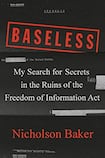
The annals of the CIA need little primping from the high-wire prose of Nicholson Baker. In Baseless, Baker documents his maddening, enlightening and ultimately inconclusive quest, wielding America’s largely toothless Freedom of Information Act, to wrest the truth from an obstructionist CIA about America’s use-or-not biological weaponry in the early 1950s.
Years elapse after Baker files requests for documents; when copies materialise, they’re ravaged by redactions that fillet them of meaning. Yet, picking over “potsherds” of text, he assembles an indelible portrait of institutional derangement.
There’s an exotic cast to Baseless. It’s replete with grim “cryptonyms”, such as GIBBETT (a “sarin nerve gas plant” under construction in Alabama) and CARCASS (an operation to train ex-Nazi collaborators to foment insurrection in the Soviet Union), and sinister-sounding anagram-like names: Detlev Bronk, Oram Woolpert, Alenda Crymble, Hubertus Strughold. (Bland or effeminate names are vivified with macho sobriquets – Hugh “Iron Pants” Johnson, Claire “Leatherface” Chennault.)
With the lethal gadgetry and hare-brained schemes (a time-release “bomb gondola” that “opened like a clamshell” to spill a payload of crop-spoiling “spores”; an idea to unleash bats synched into “napalm vests” on Tokyo during the second World War), it all suggests James Bond hokum.
But there’s little that’s campy here. The master feeling-tone Baseless evokes is horror: a flickering monochrome nightmare of 3,230 petrified guinea pigs in a mock village on a Utah military base awaiting the sorties of a bomber that will mist them with “Brucella organisms”; or a fleeing British Korean War sergeant in 1950 beholding a rearguard of masked men at the locus of subsequent reported smallpox and “hemorrhagic fever” outbreaks gingerly dispersing feathers, a known vector for biological agents, before being moved along, nothing to see here.
Allegations that US forces spread pestilence (reprised in 1952 with accusations they dropped repurposed leaflet bombs bearing cargoes of plague-ridden voles on North Korea) and, in East Germany, agricultural blight, were met with haughty derision.
Presiding over this insouciance was a cohort of buzzcut technocrats-cum-geopolitical puppet-masters, arrogating to themselves the “power to wage political war via cablegram in a suit and tie, and drop hints to newspaper columnists over cocktails in a Georgetown living room that same night”.
Even allowing for the era’s pervasive paternalism, the presumptuousness of the biological trials Baker recounts – “dusting” a low-income St Louis community, subsequent site of a cancer cluster, with carcinogenic cadmium – is staggering. Meanwhile, he convincingly traces widespread failure of US wheat crops in the early 1950s to “blowback” from CIA-cultivated spores intended to decimate Russia’s “bread basket”. This came on top of casualties within agency and military ranks from contagions at labs incubating sundry death-dealing viruses.
Burnout, crackup and suicide were legion among operatives. Director of covert operations Frank Wisner cuts an especially wretched figure, gripped by mania, before killing himself.
First-person indignation
There’s a sense of Baker unburdening himself. Baseless is marked by the first-person indignation of the private citizen – albeit a virtuosic novelist – rather than the game-face of the professional historian or journalist. This imbues it with “dear reader” zeal – “It’s time to rage against redaction! Rage against the malign succotash of self-blinkered ignorance!” – and moral conviction:
“One agency, one hypersecretive root nodule of an aberration of the hopeful human project, has been able to get away with murder for more than sixty years, using denials and redactions and national-security bumblings to control the slow doling out of its own past misdeeds.”
Elsewhere, getting personal, Baker writes, “General Nathan Twining was a solemn sad-eyed mass-murderer who liked to fish.” Lionised second World War bomber ace Jimmy Doolittle, revealed as a wannabee biological warrior, is “an awful man. Truly. An urban terrorist firebomber, an advocate of covert illegal subversion, and a would-be spreader of disease.”
This approach has its blind spots. Are Twining and Doolittle moral monsters or banality-of-evil cogs in the machine? The latter doesn’t absolve them, but it does permit more nuanced understanding than simple morality plays.
Ultimately, Baker digs up evidence that the CIA was engaged in misdirection. For the most part, those non-native rodents found in Korea weren’t diseased (he speculates they were surplus from US animal labs), only intended to unnerve the “Reds” and insinuate biological warfare capabilities America didn’t possess and knew to be prohibitively dangerous to acquire in order to steer Soviet research down “unproductive” paths. None of which rules out the US waging “a relatively small, covert [biological] effort” two years earlier, for which Baker adduces substantial evidence.
Still, much of what took place at this creepy, hysterical juncture when World War III seemed at hand remains opaque. Amid the lacunae in the record, understanding is foreclosed upon; all we have is conjecture.
“Really secrecy is about mind control. It’s about deliberately imposed historical amnesia,” writes Baker. “…By the time the truth comes out, the shock is muffled. The outrage response is inhibited.”












